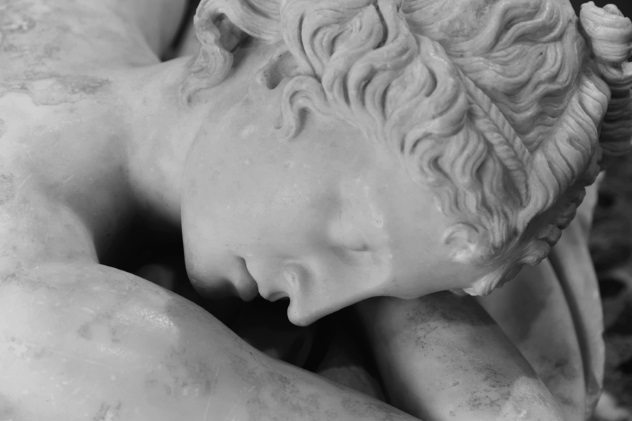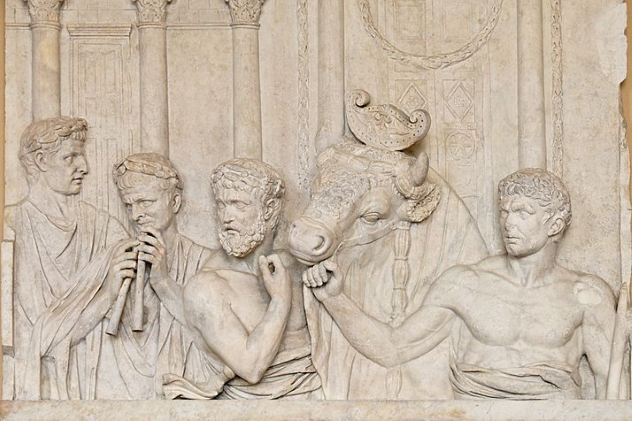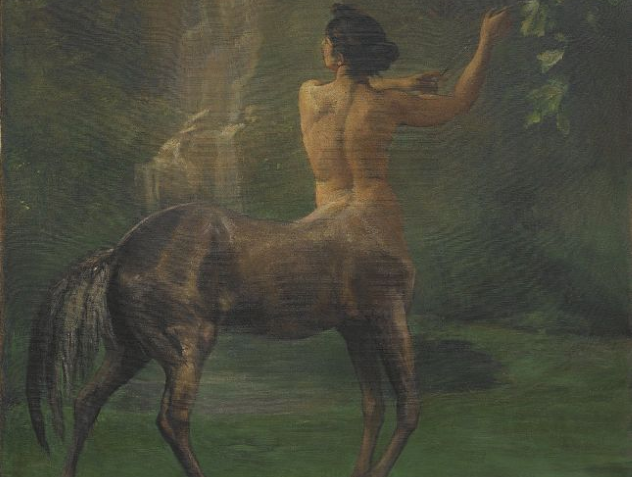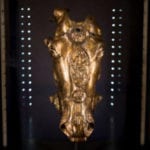 Movies and TV
Movies and TV  Movies and TV
Movies and TV  Humans
Humans 10 Times Scientists Were Absolutely Sure… and Absolutely Wrong
 Our World
Our World 10 Pivotal Moments for Life on Earth
 Movies and TV
Movies and TV 10 Most Realistic Medical TV Shows of All Time
 Creepy
Creepy 10 Eerie & Mysterious Ghosts of the Pacific Coast
 Weird Stuff
Weird Stuff 10 Typos That Accidentally Changed History
 History
History 10 Times Trickery Won Battles
 Technology
Technology 10 Awesome Upgrades to Common Household Items
 Misconceptions
Misconceptions 10 Hilarious (and Totally Wrong) Misconceptions About Childbirth
 Weird Stuff
Weird Stuff 10 Warning Labels That Exist Because Someone Actually Tried It
 Movies and TV
Movies and TV 10 Zombie Movies That Will Actually Terrify You
 Humans
Humans 10 Times Scientists Were Absolutely Sure… and Absolutely Wrong
 Our World
Our World 10 Pivotal Moments for Life on Earth
Who's Behind Listverse?

Jamie Frater
Head Editor
Jamie founded Listverse due to an insatiable desire to share fascinating, obscure, and bizarre facts. He has been a guest speaker on numerous national radio and television stations and is a five time published author.
More About Us Movies and TV
Movies and TV 10 Most Realistic Medical TV Shows of All Time
 Creepy
Creepy 10 Eerie & Mysterious Ghosts of the Pacific Coast
 Weird Stuff
Weird Stuff 10 Typos That Accidentally Changed History
 History
History 10 Times Trickery Won Battles
 Technology
Technology 10 Awesome Upgrades to Common Household Items
 Misconceptions
Misconceptions 10 Hilarious (and Totally Wrong) Misconceptions About Childbirth
 Weird Stuff
Weird Stuff 10 Warning Labels That Exist Because Someone Actually Tried It
10 Surprising Facts About Magic And Superstition In Ancient Rome
Magic and superstition have been present in human societies since the dawn of our species, and ancient Rome was no exception. Some of us would like to believe that the advancement of education and scientific knowledge should be enough to keep superstitious beliefs in check, but many signs around us tell us that superstition is here to stay. Fortune-tellers, cult leaders, horoscope writers, and casino owners (to name a few) know this very well.
This list is about the powerful effect that magic and superstition had on some of the beliefs of ancient Roman society.
10 Magic, Superstition, And Medicine

Some of the medical knowledge in ancient Rome was strongly linked to magic and superstition. Pliny the Elder records a number of health tips that few of us would take seriously. Here are some examples. Do not try this at home without medical supervision. We take no responsibility for the outcome of the following recipes:
Drinking fresh human blood was believed by some to be an effective treatment for epilepsy:
“It is an appalling sight to see wild animals drink the blood of gladiators in the arena, and yet those who suffer from epilepsy think it is the most effective cure for their disease, to absorb a person’s warm blood while he is still breathing and to draw out his actual living soul.” (Natural History, 28.4)
For treating bruises and strains:
“Strains and bruises are treated with wild boar’s dung gathered in spring and dried. This treatment is used for those who have been dragged by a chariot or mangled by its wheels or bruised in any way. Fresh dung also may be smeared on.” (Natural History, 28.237)
If you want to enhance or suppress sexual performance:
“A man’s urine in which a lizard has been drowned is an antaphrodisiac potion; so also are snails and pigeons’ droppings drunk with olive oil and wine. The right section of a vulture’s lung worn as an amulet in a crane’s skin is a powerful aphrodisiac, as is consuming the yolk of five dove eggs mixed with a denarius of pig fat and honey, sparrows or their eggs, or wearing as an amulet a rooster’s right testicle wrapped in ram’s skin.” (30.141)
9 Magic, Superstition, And Pregnancy

Pregnancy in ancient Rome was the cause of considerable anxiety. It is estimated that the number of women who died as a result of childbirth was higher to the number of men who died at war. As a result, a deficit of women suitable for marriage was always an issue in Rome. It is therefore not surprising that there were a few tips on pregnancy circulating around Roman society. Pliny the Elder tells us that:
“[ . . . ] if someone takes a stone or some other missile that has slain three living creatures (a human being, a wild boar, and a bear) at three blows, and throws it over the roof of a house in which there is a pregnant woman, she will immediately give birth, however difficult her labor may be.” (Natural History 28.33)
“If one wishes a child to be born with black eyes, the mother should eat a shrew during the pregnancy.” (Natural History 30.134)
8 Shapeshifters

Many stories circulated among ancient Romans about people changing their shape into animals and other beings. Here is one of these tales. If you think the werewolf legend is relatively new, think again:
“We came to the tombs, and my friend went to do his business among the gravestones, while I moved off singing and counting the stars. Then, when I looked back at my companion, he had taken off all his clothes and laid them at the roadside. My heart was in my mouth; I stood there practically dead. He pissed in a circle around his clothes, and suddenly turned into a wolf. Don’t think I am joking: nothing could induce me to tell lies about this. [ . . . ] He began to howl and ran off into the woods. [ . . . ] then I went to pick up his clothes, but they had all turned to stone.” (Petronius Satyricon 62)
It would not be surprising if at least some people in Rome believed stories like this one.
7 Witchcraft

Long before medieval times, witchcraft was known to the Romans. There is a famous passage in Roman literature describing a grotesque ritual performed by witches who were looking to brew a love potion. They intended to use the potion to gain the heart of a man named Varus, who had resisted the love spells cast by the witches so far.
The details of this ritual are described by the Roman poet, Horace (Epodes 5), who lived during the first century BC: A boy of high birth was kidnapped by a clique of witches. They buried the boy in the ground up to his chin, and they placed some food in the ground close to him, but he was unable to reach it. The witches hoped to starve the boy to death and make his liver grow as a result of the hunger. The boy’s liver was a key ingredient to brew the love potion.
This account is fictional, but it shows the place that witches and their dark arts had in the imagination of some Romans.
6 Interpretation Of Dreams

Like almost all other cultures, some Romans firmly believed in the idea that dreams could forecast the future. In the second century AD, Artemidorus of Daldis wrote a work named The Interpretation of Dreams, compiled in five books. Some of the ways in which he interpreted the meaning of dreams are both specific and curious:
“Dreaming about turnips, rutabagas, and pumpkins presages disappointed hopes, since they are massive [vegetables] but lack nutritional value. They signify surgery and wounding with iron implements for sick people and travelers, respectively, since these vegetables are cut into slices.” (1.67)
“Dreaming that one is eating books foretells advantage to teachers, lecturers, and anyone who earns his livelihood from books, but for everyone else it means sudden death.” (2.45)
5 Reading Animal Entrails

Hundreds of techniques to foretell the future are recorded in ancient Roman documents. We know, for example, that sacrificing animals and trying to read the future by interpreting their entrails was practiced not only in ancient Rome, but also in many other cultures. This magical art was known to the Romans as haruspicy, and a person trained in this art was a haruspex.
Cicero (On Divination: 2.52) claims that Hannibal, the renowned Carthaginian commander who defied Rome in the Second Punic War, was an expert in this technique. While he was still a military advisor (before he became commander), he used to give advice to his superiors based on the messages he could read on the organs of sacrificed animals.
4 Astrology

Trying to predict events based on the position of the celestial bodies was also widely practiced in the Roman world. Some Roman emperors, including Tiberius, Domitian, and Hadrian, believed in divination and astrology and even had some degree of training in these arts. Cassius Dio (Roman History 57.15) claims that Tiberius had a man executed after he had a dream in which he was giving money to that same man. Tiberius believed that he had that dream under the influence of some sort of enchantment.
However, there is evidence that not everyone was persuaded by the astrologer’s claims:
“I am amazed that anyone could continue to put their trust in such people, when the falseness of their predictions is every day made clear by what actually happens.” (Cicero, On Divination: 2.99)
The love-hate relationship that Rome had with astrologers was expressed by Tacitus with his typical directness:
“Astrologers are treacherous to the powerful and unreliable to the merely hopeful; they will always be banned from our state, and yet always retained.” (Histories 1.22)
3 The Shield Of Mars

The Romans believed that the god Jupiter gave the very shield of the god Mars to Nula Pompilius (the second king of Rome). This relic was known as the Ancile. It was believed that if the Ancile was harmed in any way, so would the nation of Rome. In other words, the prosperity of Rome was dependent on the integrity of the Ancile. Therefore, it was decided that the safest place to keep this relic was the Temple of Mars.
The nymph Egeria advised the king of Rome to create eleven identical copies of the shield in order to confuse potential thieves and keep the shield safe. A body of priests known as the Salii were responsible for protecting the Ancile and, ultimately, the prosperity of Rome.
2 The King Of The Wood

A shocking ritual was recorded at the grove of the goddess Diana at Aricia, south of Rome along the Via Appia (the road connecting Rome with Capua), by the shores of Lake Nemi. The grove of Diana had a priest, known as Rex Nemorensis. Those who held the position were always fugitive slaves who became priests by murdering the acting priest. This was the accepted norm of succession for the priesthood of Diana. As a result, the Rex Nemorensis was always on alert, carrying a sword, waiting for the next candidate to challenge him, and fearing for his life. (Strabo, Geography 5.3). This practice is summed up by T. Macaulay:
“From the still glassy lake that sleeps
Beneath Aricia’s trees—
Those trees in whose dim shadow
The ghastly priest doth reign,
The priest who slew the slayer,
And shall himself be slain”
The exact justification for this succession rule is not fully understood, and it has sparked the imagination of many historians and writers. Nobody has explored this issue in more depth than Sir James George Frazer, who used the institution of the Rex Nemorensis as a starting point of his colossal anthropological work The Golden Bough: a Study in Magic and Religion, published in 1890.
1 Imaginary Beasts

Ancient Roman writers left a number of accounts describing several imaginary animals. Interestingly, most these beasts were exotic, coming from remote locations.
Pliny (Natural History 8.75) describes a half-human, half-horse animal named the hippocentaur. According to his doubtful account, he personally saw one of these beasts shipped from Egypt to the emperor Claudius, preserved inside a container filled with honey.
Aelian also describes some peculiar species of one-horned donkeys and horses found in India. Drinking vessels made out their horns had a unique property: If poison was poured into them, the horns would cancel the effect of the poison, acting as an antidote. (On Animals 3.41).
Aelian (On Animals 9.23) reports the existence of the amphisbaena, a snake with one head at both ends:
“When it is going forward, it uses one head as a tail, the other as a head, and when it is going backward, it uses its heads in the opposite manner.”
Aelian fails to explain what relevance the terms “forward” and “backward” may have when applied to a being with a head at both ends, but we get his point.








